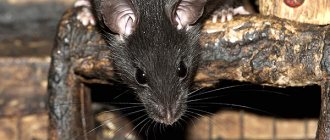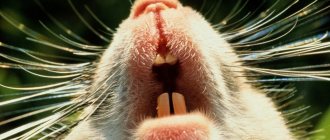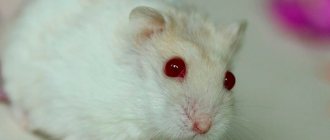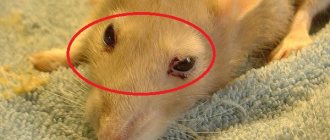Escape is not the only cause of this disease, however, it is one of the most common.
It often happens that conjunctivitis appears due to the fact that the owner of the animal forgot to change the bedding in the cage in time.
Also, the development of this disease is fraught with treating your pet with fruits and vegetables from the list of prohibited ones. In this case, inflammation develops based on allergic reactions, and a careless owner will have to find out why the hamster’s eyes fester, what to do in such a situation, and how to save the pet.
Causes of eye diseases
Hamsters are susceptible to various infections and age-related diseases. Eye diseases are quite common among them. If you don’t know why the hamster doesn’t open its eye, look into this issue. This will help to heal the fluffy faster and avoid illnesses in the future.
Here are the main reasons:
- Unsanitary conditions. The most common cause of eye infections in hamsters. In a filler that has not been changed for a long time, pathogenic microorganisms multiply at incredible speed. But homa likes to burrow into the litter, so the likelihood of picking up an infection is very high.
- Allergy. If you feed your pet all sorts of exotic foods, then don’t be surprised that your hamster’s eyes are watery. This is a common allergic reaction. Allergies can also be triggered by the chemicals you used to wash the cell.
- Injuries. Injuring the eyes of hamsters is not that difficult. The animal can prick its eye with hard hay or drive a piece of sawdust litter under the eyelid. But if a hamster has one eye closed, most likely the animal’s cheek is damaged: it is so swollen that the eye closes by itself.
- General decrease in immunity. It has been noted that conjunctivitis in hamsters is often accompanied by pneumonia, tuberculosis and viral diseases of the respiratory tract.
There are also senile changes in the organs of vision, in which white spots appear.
Preventive measures
Agree, it is better to prevent any disease in domestic hamsters than to treat it later. And for this you need to create the necessary conditions for your pet.
Considering the causes of such diseases, caring owners should:
- Use cage mats specifically designed for hamsters. Such material should not contain piercing or cutting objects, as well as a lot of dust.
- You should not keep a large number of rodents in one cage. They can injure each other, which will result in various diseases, including eye diseases.
- Genetically predisposed individuals must be immediately excluded from the general “herd.” Such hamsters can be a carrier of an infection from birth, transmitted to them from their mother or father.
- During the keeping process, the cage with rodents must be placed in a bright place, but protected from the sun. Direct exposure to sunlight and ultraviolet radiation negatively affects the health of pets.
- Regular examination of animals will help you at an early stage to identify not only carriers of diseases, but also to prevent the development of an already established disease in hamsters.
Common symptoms of eye diseases
How can you tell if your Homa has problems with his eyes? It is necessary to examine the animal daily so as not to accidentally miss the disease. You should be concerned if:
- Hamsters' eyes are wet;
- swollen eyelids;
- mucous discharge from the eye appeared;
- the pet does not open its eyes or at least one of them;
- fur began to come out on the eyelids;
- The hamster's eye turned white in the pupil area.
Cloudiness of the pupil is typical for old animals, but other symptoms occur in pets of all ages. Most often they are caused by diseases of bacterial origin.
Age-related changes
If a hamster has a white spot on its eye, this indicates that the animal is beginning to undergo senile changes in its body. This disease is called cataracts and occurs in all mammals. It is caused by clouding of the lens. More often the eye becomes cloudy in the area of the pupil, less often along the periphery. At first the spot is gray, gradually turning white.
The development of cataracts in rodents is caused by stress, eye injuries, and sometimes the disease results from other ailments: diabetes mellitus in dzhungarik, food poisoning. The risk of cataracts increases if the animal's cage is regularly exposed to the sun.
Unfortunately, there is no cure for this eye disease in hamsters; it is impossible to get rid of it. But there are tips that will help significantly reduce the risk of developing the disease:
- Do not leave the animal's house in the sun.
- Don't give your home a lot of sweets.
- Make sure your diet is rich in carotenoids; they are found in carrots, parsley, zucchini and other foods of plant origin.
- Treat your animal's eye infections promptly.
In rare cases, furry cats have congenital cataracts. What to do if your pet has an eyesore? Hamsters don’t have very good eyesight anyway, but with this problem they can see completely poorly. Therefore, do not clutter the cage with furniture, as this can lead to injury.
Treatment of diseases
After the examination and identification of the disease, the veterinarian prescribes treatment for his “little patient,” which consists of several stages:
- if a hamster’s eye festers, this is a sign of a bacterial infection that needs to be destroyed;
- saving the eyeball, if possible;
- reduce the risk of further damage to the organ of vision;
- numb the painful area;
- and only at the very end the specialist begins to treat the underlying disease that caused inflammation of the visual organs (glaucoma, dental disease, injury, etc.).
Diet restrictions
Consider one more point: the immunity of a sick rodent, like that of any pet, weakens during illness. Therefore, special attention should be paid to nutrition here. You can feed the animal only approved products. You should also exclude some permitted treats from your diet so as not to aggravate the course of the disease.
Dietary treatment consists of cereals, a small portion of animal protein. The animal's water needs to be changed several times a day.
If within a few days you have not noticed an improvement in the condition of your sick pet, you have no other choice but to take him to the veterinarian.
Bacterial infections
If you notice that your hamster's eyes are festering, it means that your pet has picked up a bacterial infection. Its common pathogens are spherical and rod-shaped bacteria: staphylococcus, clostridium, E. coli, streptococcus, etc. Once under the eyelid, they begin to actively multiply. To fight them, the body sends protective cells - leukocytes, various enzymes and other substances that destroy the bacterial wall. As a result, pus is formed - a viscous substance containing living and dead bacteria.
There are several bacterial eye diseases. If your hamster's eye is festering, it could be one of the infections discussed below.
Conjunctivitis
The disease is not dangerous if left untreated. The disease in most cases is caused by pathogenic microflora and only occasionally has an allergic origin. First, the animal’s eyes begin to water; at this stage, few are able to recognize the disease. Then more reliable symptoms appear:
- The hamster's eye is rotting. Pus is a yellow or greenish mass that collects in the corners of the eye;
- the eyelids become inflamed and may swell;
- the palpebral slits narrow until the eye closes completely;
- the animal becomes apathetic and may lose appetite.
If a hamster's eyes fester, it is important to start treatment on time, since pathogenic flora can spread to the eyelids from the inside and outside, the hair will begin to come out, and the pet will be very uncomfortable. As a result of advanced conjunctivitis, the eyes may close completely, and this is a huge stress for the animal.
Few people know how to treat conjunctivitis in domestic rodents and whether it is possible to use a human first aid kit. Of course, it is better to make an appointment with your veterinarian to get professional advice. But if this is not possible, you will have to care for the fluffy yourself.
Doctors do not recommend smearing the eyes of rodents with tetracycline ointment. It is better to use Albucid drops, drip them three times a day. Treatment of hamsters, depending on the degree of neglect of conjunctivitis, will last from 3 days to 2 weeks.
Important points in treatment and prevention:
- A sick hamster should be isolated from healthy individuals if you have several rodents.
- Every eye of the animal is treated, even if suppuration is noticed in only one. This is done so that the animal does not transfer the infection from one eye to the other while washing.
- During conjunctivitis, it is better to change the litter daily.
- Eliminate sweets from the diet for a while, give only grains, nuts and unsweetened vegetables.
- To reduce the chance of eye infection, clean the cage frequently. Also make sure that children play with the hamster after washing their hands first.
Conjunctivitis cannot be left untreated; this will lead to the eye not opening at all, or, on the contrary, it may “pop out.”
Blepharitis
Usually a complication of conjunctivitis, with inflammation spreading to the eyelids. They turn red and itch terribly, the hamster rubs its eyes, which is why the hair quickly falls out. If you bring your pet with these symptoms to the veterinarian, he will tell you in detail why the hamster's eye is swollen. The doctor will tell you how to properly treat blepharitis.
Usually, in case of purulent inflammation of the eyelids, the same eye drops are prescribed as for conjunctivitis. In addition, it is recommended to smear the animal’s eyelids with tetracycline ointment. Sanitation and diet are also similar to those for conjunctivitis.
bulging eye
It happens that one eye of a homa becomes larger than the other and seems to stick out a little. If a hamster's eye pops out, this is a consequence of injury (for example, falling from a height) or an advanced infection. Conjunctivitis can spread not only to the eyelids. Bacteria can penetrate into or under the eyeball. There they begin to divide, a lot of pus is formed, which seems to squeeze the eye out.
The situation is very serious, you will not be able to cope with it on your own. The prognosis is also disappointing: in most cases, the animal is prescribed surgery to remove the organ of vision.
“False” eye diseases
Sometimes the reason why a hamster's eyes won't open is due to other illnesses. For example, a severe inflammatory process in one of the cheek pouches. Because of this, the animal's cheek swells and props up the lower eyelid. As a result, the hamster is unable to fully open its eyes.
To help the animal, you should take it to the veterinarian for a cheek cleaning procedure. Eye drops and ointments are not needed at all.
The main condition for maintaining the health of your pet's eyes is cleanliness. Wash the cage often and do not touch the animal with dirty hands. But if your pet has an inflamed eye, treat it with special drops. Do not forget to isolate the sick rodent from a common cage if you have several hamsters, because eye diseases are very contagious.
Blepharitis
This disease may be a consequence of advanced conjunctivitis. In this case, the inflamed eyelid sticks together, and the inflammatory process spreads deeper and deeper inside. At an advanced stage, both organs of vision may be closed. This disease is accompanied by redness and swelling of the eyelids.
What to do in this case? This disease can be treated if you consult a veterinarian in time. Often the treatment regimen is identical to the treatment regimen for conjunctivitis. Often, special eye drops are used in the treatment of this disease, for example Tsiprovet or Floxal, as well as additionally tetracycline ointment.
With this disease, the hamster should be put on a diet and the cage should be disinfected.
Bulging eyes
This is more likely not a disease, but a consequence of injury to the eyeball, which has a bad effect on the general condition of the animal. A hamster can damage its eyes both in the fight against other rodents for survival and from dangerous objects contained in the cage - wood chips, sawdust, wire, etc.










